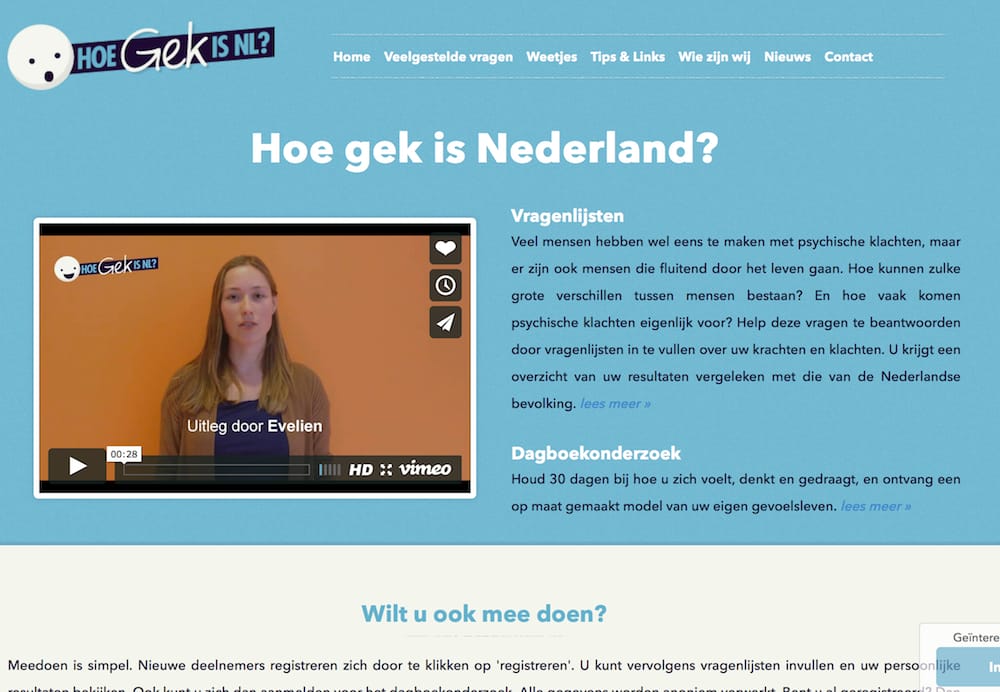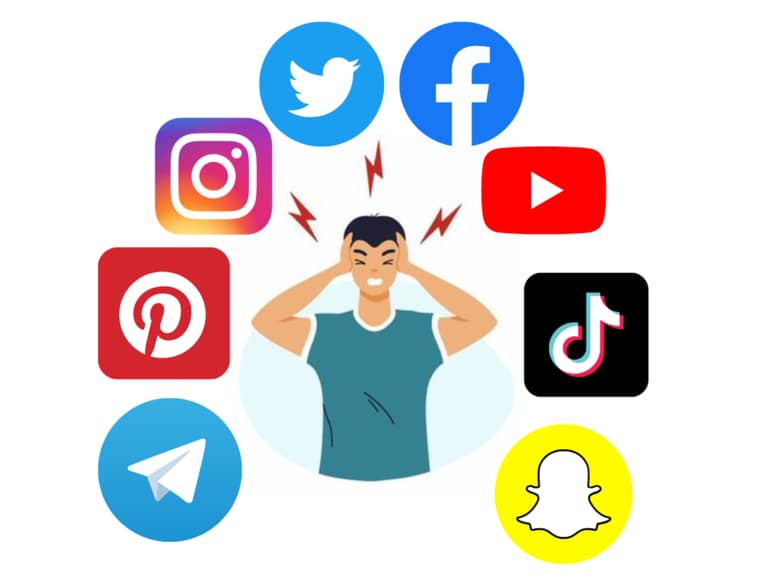
HoeGekIs.NL – How Nuts Are The Dutch?
HoeGekIsNL is a national crowdsourcing study designed to create an empirically based representation of mental strengths and vulnerabilities and their role in mental disorders. It is an initiative of the Interdisciplinary Center Psychopathology and Emotion regulation (ICPE), UMCG. The team behind the project is led by professor Peter de Jonge and is comprised of scientists from different fields, including psychiatric epidemiology, psychology, computer science, and mathematics.
Many people occasionally feel blue – some end up developing depression. Faced with extreme circumstances, some people enter a depressive state – others remain seemingly undisturbed despite problems in life. How can there be such big differences between people? And what could explain them? HoeGekIsNL is a project aimed at generating hypotheses and later answering such questions. From the get-go, the researchers emphasize they are not interested in a black-and-white approach and advocate that a sharp distinction between ‘normal’ and ‘not normal’ is not useful. Instead, they are attempting to figure out what combination of factors influences the development of depression. They also state that examining psychologically robust people may help zero in on what actually helps fight mood disturbances.
A single measurement cannot determine how feelings, thoughts and behavior influence each other, so the main part of this research is a diary study in which participants repeatedly take measurements in their daily environments (prompted by texts with, if unused in allocated time, self-deactivating links). The outcome will help shed light on whether, for example, depressed people are happier when they are busy or when they relax at home. These kinds of relationships are sometimes invisible to the naked eye, but can be traced by means of statistical tools.
There is no financial compensation for taking part in the research; instead, what participants get in return depends on how much they put in. If they fill in the diary often enough (75% of the time), they get a personal, automatically- generated report that provides information about patterns in their emotional life and behavior. If they fill in 85% of the measurements, the analysis includes a component that describes how their strengths and vulnerabilities interact.
So how does it work? It seems simple: you go to the website HoeGekIsNl.nl, fill out a registration form, and you’re only a couple of clicks away from becoming a participant in a giant research project that already has had more than 12000 participants. Red flag: before taking part in specific research assignments, you are asked to submit a number of personal details, such as your gender, age, postal code, relationship status, both your own and your parents’ country of origin, family income, living arrangement, religion, living situation, occupational situation, and many others. Then you can move on to questionnaires. One of them based on DSM criteria: your mental health may be investigated by means of questions about (another red flag!) suicidal ideation, fatigue, or changes in weight. Participation is officially open to 18+ Dutch and Belgian citizens, although over 200 legal minors participated in the project, as admitted by the research group.
I identified two red flags in the paragraph above: details about mental health combined with a participant’s proximate address, ethnicity, and income are collected within one project, although stored on two separate servers. The researchers promise that the privacy of participants will not be breached and access to both datasets will only be granted to an administrator (the person however is not named). However, security of data, especially medical data, is not a trivial thing, and I therefore sincerely hope that the HoeGekIsNL research is safeguarded extremely well. This information should not fall into the wrong hands.
The unquestionable benefits? A wonderful example of strategically marketing a project. The website of HoeGekIs.NL has been developed with a sleek design and is promoted in an attractive language (look no further than the tongue-in-cheek name), often rare in communicating science. It comes as no surprise the project has been met with a warm response of over 12000 participants.
“Perhaps there is no such thing that gives greater happiness than what one does for other people.” (D. Bonhoeffer, own translation). Indeed, a two-way interaction is a very fulfilling aspect of citizen science when it helps educate, gather gigantic datasets, and garner financial support by providing tangible examples of utility of research. Although a large online study inherently suffers from a response bias, HoeGekIsNL may help generate new hypotheses about how key variables interact to create a mental condition.
This article was written by Alexander Pietrus-Rajman and first appeared in the 100th issue of the BCN Newsletter.




Thank you for this nice article about HowNutsAreTheDutch (HND). We confirm that the HND research is safeguarded extremely well (see doi:10.1002/mpr.1495 or doi: 10.1109/SOCA.2015.25 for details). In short, personal information (e.g., socio-demographic data and postal code area) are stored separately from the questionnaire data using different database management systems for each type of data, on two physically different servers. The questionnaire data is stored locally using a specialized medical service known as RoQua (www.roqua.nl). Both databases have to be compromised to trace questionnaire data back to potentially identifying personal information. All web traffic to and from the HND website is encrypted with a 128bit TLS-2048bit RSA Secure Socket Layer (SSL) certificate, which ensures that any data exchanged between participants and the HND website application is unreadable for anyone else. Regarding the data from minors, these are automatically excluded from the extracted dataset. Everyone is welcome to participate.